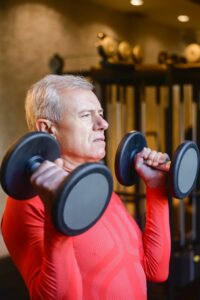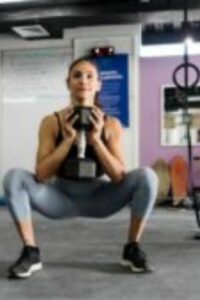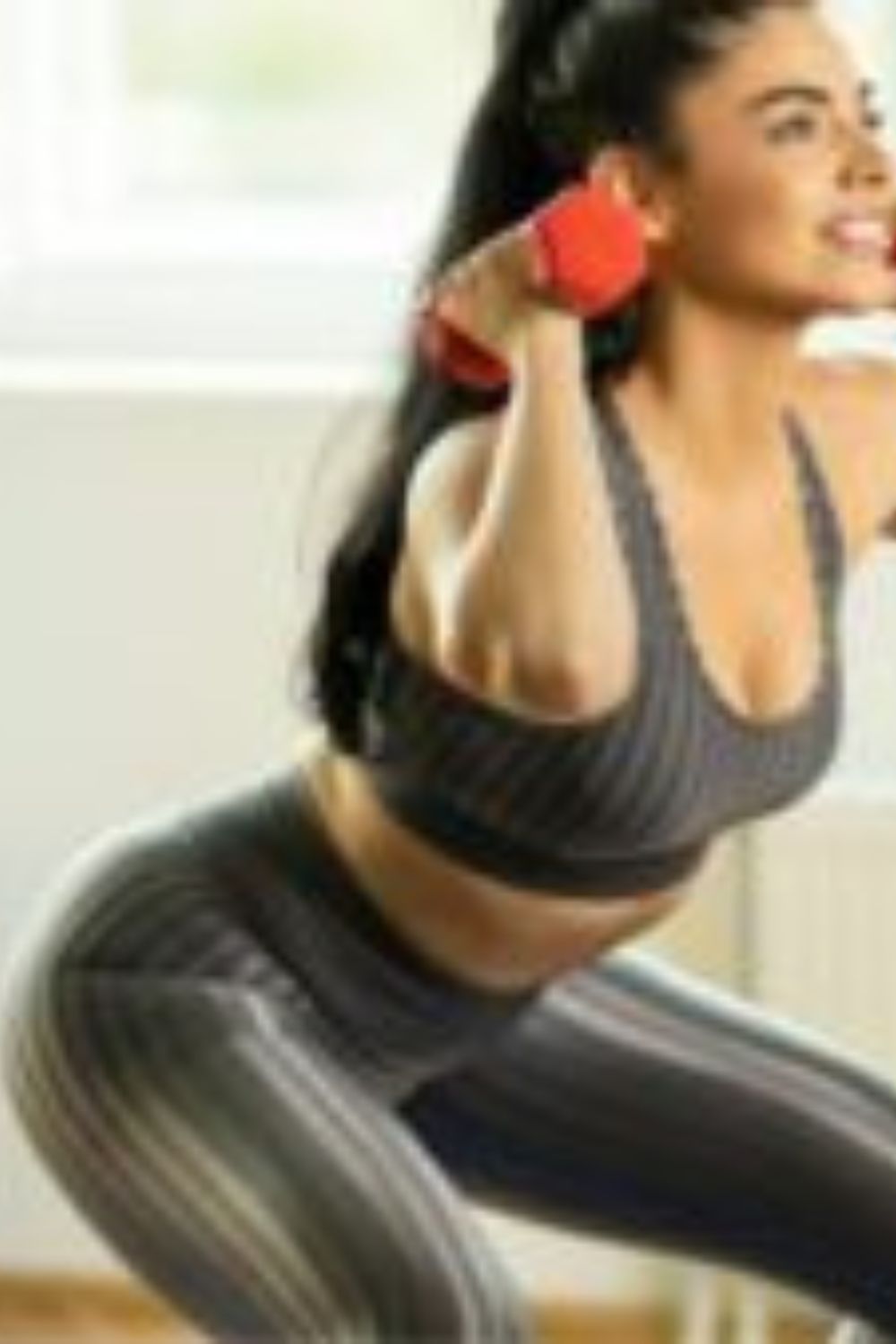Have you ever wondered if your facial expressions make a difference when you’re doing dumbbell squats?
Well, you’re not alone! In this blog post, we’ll dive into the intriguing question of whether how you face really matters during this popular strength-training exercise.
Let’s explore the surprising ways your facial expressions can impact your squatting experience.
The Hidden Role of Your Face in Dumbbell Squats: Does It Matter?
Yes, your facial expression can have an impact on your performance and safety when performing dumbbell squats.
While it may not be the most critical factor, it can still be relevant for several reasons:
Breathing and Focus: Maintaining proper breathing is crucial during squats to support your core and stabilize your body.
Your facial expression can reflect your level of focus and concentration. If you’re grimacing or making strained facial expressions, it might indicate that you’re not breathing correctly or that you’re struggling with the weight.
Neck Position: Your facial expression can also be an indicator of your neck position. It’s important to keep your neck in a neutral position, in line with your spine, during squats.
If you’re craning your neck or twisting it in an awkward way, it can lead to neck strain or injury.
Pain or Discomfort: Sometimes, facial expressions can reveal discomfort or pain. If you’re experiencing pain during the squat, it’s crucial to address the issue immediately.
Ignoring pain can lead to injuries or improper form, which can be detrimental to your progress.
Mental State: Your facial expression can reflect your mental state during a workout. If you’re feeling confident and focused, your expression might be more relaxed.
On the other hand, if you’re anxious or unsure, it might manifest in tense facial muscles.

While it’s essential to pay attention to your facial expressions as one aspect of your form, it’s equally important to focus on other key elements of proper squat technique, such as:
- Foot Placement: Ensure your feet are shoulder-width apart, with toes slightly turned out.
- Hip Hinge: Initiate the squat by pushing your hips back and bending at the knees.
- Depth: Aim to squat until your thighs are parallel to the ground or lower, while keeping your back straight.
- Back Position: Maintain a neutral spine throughout the movement.
- Knee Tracking: Keep your knees in line with your toes, preventing them from collapsing inward.
Ultimately, a successful squat depends on proper form, concentration, and safety.
While your facial expression can provide some clues about your performance, it should not be your primary focus.
Instead, concentrate on maintaining correct form and listening to your body to ensure a safe and effective squat.
Further explanations here.
Let’s delve into more detail about the relationship between facial expressions and these crucial aspects of dumbbell squats:
1. Breathing and Focus:
Proper Breathing: When performing squats, it’s vital to breathe correctly to support your core and maintain stability.
The Valsalva maneuver is a common technique used during heavy lifts like squats. This technique involves taking a deep breath before descending into the squat, holding your breath as you lift the weight, and then exhaling at the top
. The increased intra-abdominal pressure created by holding your breath helps stabilize your spine and core.
Facial Expressions: Your facial expressions can provide insight into how well you’re managing your breath. If you’re grimacing or making strained facial expressions, it may indicate that you’re not following the breathing technique correctly. For instance, if you’re exhaling too soon during the ascent, it can reduce your core stability and potentially compromise your form.
2. Neck Position:
Neutral Neck Alignment: Maintaining a neutral neck position during squats means keeping your head and neck in line with your spine. Your gaze should typically be forward or slightly upward, not craning your neck up or down.
Facial Expressions: Your facial expressions can reveal if your neck position is incorrect. For example, if you’re looking upward excessively or twisting your neck to the side, it’s a sign that you might not be maintaining a neutral neck alignment. Twisting or craning your neck in an awkward way during squats can lead to unnecessary strain on the cervical spine and increase the risk of injury.
In other words, your facial expressions can act as indicators of your breathing and neck position during dumbbell squats.
By paying attention to your facial expressions, you can become more aware of any potential issues with your technique.
If you notice grimacing or strained expressions, it’s a signal to reassess your breathing pattern and neck alignment to ensure that you’re performing squats safely and effectively. Proper technique not only reduces the risk of injury but also helps you maximize the benefits of the exercise.
let’s explore in more detail the relationship between facial expressions and these two aspects of dumbbell squats:
3. Pain or Discomfort:
Facial Expression as a Signal: Your facial expressions can be a valuable indicator of pain or discomfort during dumbbell squats.
Pain is your body’s way of signaling that something may be wrong, and ignoring it can lead to injury or compromised form.
Types of Pain: Facial expressions can vary depending on the type of discomfort you’re experiencing.
For example, if the dumbbell squat is causing pain in your knees or lower back, you might grimace or wince.
Recognizing these expressions can prompt you to stop the exercise or adjust your form to avoid potential injury.
Adjusting Form: If you notice pain-related facial expressions, it’s essential to address the issue promptly. You can do this by assessing your form, reducing the weight, or even consulting a fitness professional to ensure you’re performing the exercise correctly.
4. Mental State:
Facial Expression and Confidence: Your facial expressions can also reflect your mental state during a workout. Confidence and focus are essential for performing exercises effectively and safely.
Confidence and Relaxation: When you’re confident and relaxed, your facial expression may appear more composed and at ease. This is often seen when individuals are in their element, executing squats with a sense of assurance and control.
Anxiety and Tension: Conversely, if you’re feeling anxious or unsure, it might manifest in tense facial muscles. You may furrow your brow or appear visibly tense. This can affect your ability to maintain proper form and can even increase the risk of injury.
Mental Preparation: Recognizing these mental cues through facial expressions can be an opportunity to focus on mental preparation techniques, such as visualization and positive self-talk, to improve your confidence and concentration during squats.
Overll, your facial expressions can provide valuable insights into your physical and mental state during dumbbell squats.
Pain-related expressions signal potential issues that need immediate attention, and monitoring your mental state through your facial expressions can help you work on confidence and focus.
Paying attention to these cues can contribute to safer and more effective squat workouts while reducing the risk of injury.
Here are proper squat techniques to follow:
let’s provide a more detailed explanation of each of these key elements of proper dumbbell squat technique:
1. Foot Placement:
Shoulder-width Apart: When setting up for a dumbbell squat, stand with your feet positioned approximately shoulder-width apart. This width provides a stable base of support for the squat.
Toes Slightly Turned Out: Toes can be turned out slightly, usually at about a 5 to 20-degree angle. This external rotation of the feet can help with hip mobility and alignment during the squat.

2. Hip Hinge:
Initiation: The squat begins by initiating a hip hinge. To do this, push your hips back as if you’re sitting down into a chair.
This movement should be the first action, and it allows you to maintain balance and engage your posterior chain (hips, hamstrings, and glutes).
3. Depth:
Thigh Parallel or Lower: As you descend into the squat, aim to go deep enough so that your thighs become parallel to the ground or go even lower. This depth ensures that you’re engaging the major muscle groups in your lower body effectively.
Back Straight: While reaching this depth, it’s crucial to keep your back straight. Avoid rounding or arching your back. Maintain a neutral spine, which means your back should have a natural, slightly arched curve without excessive flexion or extension.
4. Back Position:
Neutral Spine: Throughout the entire squat movement, maintain a neutral spine. This means keeping your back in a position that preserves the natural curvature of your spine without excessive rounding or arching. This helps distribute the load evenly across your back and reduces the risk of injury.
Core Engagement: Engage your core muscles to help stabilize your spine and protect your lower back.
5. Knee Tracking:
Knees Aligned with Toes: Ensure that your knees stay in line with your toes throughout the squat. They should not collapse inward (valgus collapse) or push outward excessively. Keeping your knees aligned helps prevent undue stress on the knee joints and maintains proper tracking.
In summary, a successful dumbbell squat involves proper foot placement for stability, initiating the movement with a hip hinge, achieving the correct depth while maintaining a straight back and neutral spine, and ensuring that your knees track in line with your toes.
Paying attention to these key elements of technique will help you perform squats safely and effectively while maximizing the benefits for your lower body muscles.
A complete tabular on this topic here.
Here’s a complete tabular breakdown of how your facial expressions can matter in dumbbell squats:
| Aspect | Importance | How Facial Expression Matters |
|---|---|---|
| Breathing and Focus | High | Facial expressions can reflect your level of focus and breathing. Grimacing or strained expressions may indicate improper breathing or struggle with the weight. |
| Neck Position | Moderate | Facial expressions can indicate neck position. Craning or twisting the neck can lead to strain or injury. A neutral neck alignment is essential. |
| Pain or Discomfort | High | Facial expressions can reveal discomfort or pain during squats. Ignoring pain can lead to injuries or improper form, affecting progress. |
| Mental State | Moderate | Your facial expression reflects your mental state. Confidence and focus are important for safe and effective squats, while anxiety or tension can hinder performance. |
These aspects illustrate how your facial expressions can be indicative of various factors during dumbbell squats. Monitoring your facial expressions can help you maintain proper form, identify discomfort or pain, and assess your mental state to improve your overall squatting experience.
My concise conclusion here: Doesn’t how you face matter in dumbells squat?
In conclusion, your facial expressions do matter in dumbbell squats. They can provide valuable cues about your breathing, neck position, pain or discomfort, and mental state.
Paying attention to your facial expressions can help you maintain proper form, prevent injury, and optimize your performance during this exercise.

Hey there, it’s Mike Rrsq, the Editor-in-Chief over at Jsquat.com, and I’m absolutely obsessed with all things squat fitness! I’ve been lucky enough to get some serious recognition for my work in this field. With a solid background in the fitness and wellness industry, I’ve been there right from the get-go, helping shape this website into what it is today.
You see, I’m not just the boss around here; I’m also a passionate contributor. I love sharing my insights through my articles, and trust me, they’re not your run-of-the-mill stuff. Each piece I write is a labor of love, filled with my expertise and real-world experience in the fitness universe. So, if you’re into fitness and looking for some inspiration, you’re in the right place!

